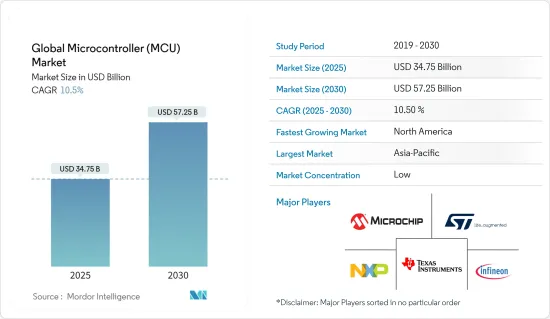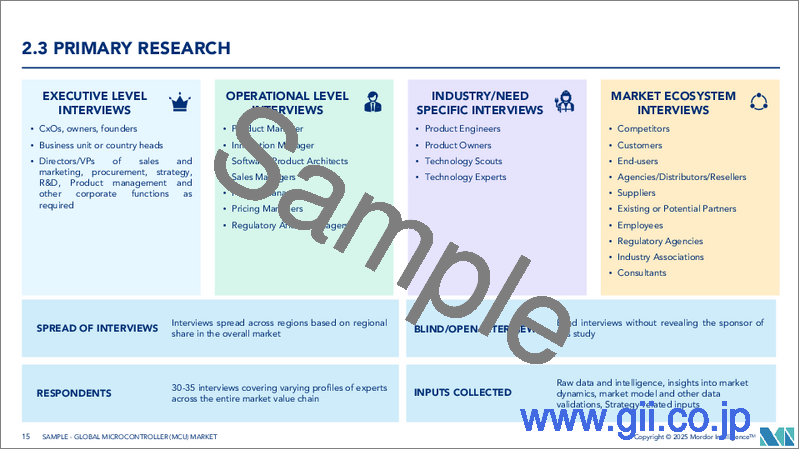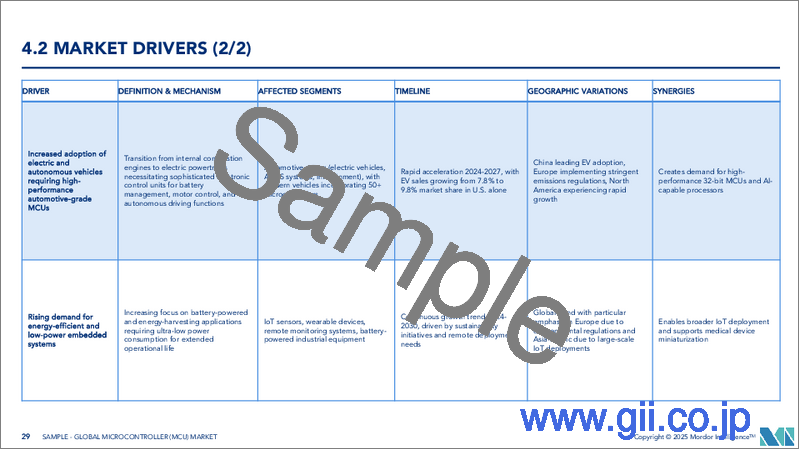|
|
市場調査レポート
商品コード
1644540
マイクロコントローラ(MCU):世界の市場シェア分析、産業動向と統計、成長予測(2025年~2030年)Global Microcontroller (MCU) - Market Share Analysis, Industry Trends & Statistics, Growth Forecasts (2025 - 2030) |
||||||
カスタマイズ可能
適宜更新あり
|
|||||||
| マイクロコントローラ(MCU):世界の市場シェア分析、産業動向と統計、成長予測(2025年~2030年) |
|
出版日: 2025年01月05日
発行: Mordor Intelligence
ページ情報: 英文 120 Pages
納期: 2~3営業日
|
全表示
- 概要
- 目次
マイクロコントローラ(MCU)の世界市場規模は、2025年に347億5,000万米ドルと推定され、予測期間中(2025-2030年)のCAGRは10.5%で、2030年には572億5,000万米ドルに達すると予測されます。

主なハイライト
- マイクロコントローラ(MCU)はコンピューティング・ユニットとして機能し、多様な周辺機器や組み込みシステムを管理します。これらのシステムは、家電製品や自動車からロボットや産業機器まで多岐にわたる。プロセッサ・ユニット、入出力(I/O)ポート、オンチップ・ストレージ、無線通信モジュールなどのコンポーネントを統合することで、マイクロコントローラ(MCU)は特定の機能向けにカスタマイズできます。マイクロコントローラ(MCU)の使用急増の主な要因は、データ収集と運用監視のためのセンサへの依存度が高まっていることです。個別の用途向けにプログラムされたこれらのデバイスは、操作シーケンス内でのシームレスなデータ交換を可能にします。
- マイクロコントローラ(MCU)は、ロボット工学、自動車、家電、医療機器に普及しています。手頃な価格、エネルギー効率、コンパクトなサイズにより、組み込みシステムに最適な選択肢となっています。これらの分野にとどまらず、マイコンは、ホームオートメーション、製造、自動車、スマートエネルギー、通信、モノのインターネット(IoT)の導入など、さまざまな業界で応用されています。
- モノのインターネット(IoT)の台頭、コスト効率に優れたエネルギー効率の高いコンピューティングへの需要、無線通信技術の進歩などの要因が、マイコンの人気を後押ししています。デジタル変革のためにIoTを活用する企業が増えており、IoTマイコンの見通しは依然として明るいです。IoT技術の進化に伴い、これらのマイコンは、多数のIoTアプリケーションの接続性とインテリジェンスを強化する上で極めて重要な役割を果たすことになります。
- 相互接続されたデバイスを世界に提供することを目指すIoTアプリケーションの技術的進歩は、マイクロコントローラ(MCU)の需要を押し上げることになるでしょう。エリクソンは、短距離IoTデバイスの急増が原動力となり、2022年から2028年にかけて世界に接続されるデバイスがほぼ倍増し、2028年には287億2,000万台に達すると予測しています。この市場拡大は、消費者部門と企業部門の両方でIoTの導入が進み、エネルギー効率が高く高性能なコネクテッド製品の必要性が強調されていることが、さらに後押ししている可能性があります。
- 世界のマイクロコントローラ(MCU)市場の分析には、多様な用途に合わせた4ビット、8ビット、16ビット、32ビットマイクロコントローラ(MCU)など、さまざまなカテゴリーが含まれます。マイクロコントローラ(MCU)市場の特徴は、業界をリードする企業が新製品を定期的にイントロダクションしていることです。例えば、STMicroelectronicsは2023年3月、Arm Cortex-M33コアを搭載したSTM32WBA52マイクロコントローラ(MCU)を発売し、携帯医療機器、センサー、スマートホームなどの用途をターゲットとしています。
- マイクロコントローラ(MCU)市場の大幅な成長は、自動車および家電分野が牽引すると予想されます。マイクロコントローラ(MCU)は、自動車のエンジン、トランスミッション、ブレーキなどのシステム管理に不可欠です。さらに、電気自動車(EV)への投資の増加、自律走行、EV販売の急増も成長を後押ししています。車載以外にも、マイコンはスマートフォンやタブレットなどの家電製品に不可欠であり、5GやIoT技術の採用が需要に拍車をかけています。
- 高度なアーキテクチャを持つマイコンは、より高性能なデバイスと直接インターフェースすることができず、実行能力の制限による動作上の制約に直面しています。相補型金属-酸化膜-半導体(CMOS)技術を使用して構築されているため、静電気による損傷にも弱いです。
- COVID-19の大流行は、調査対象市場のサプライチェーンと生産を大きく混乱させました。しかし、サプライチェーンはデジタル化と自動化によって回復の兆しを見せています。主な成長促進要因としては、デジタル化への世界の投資、5G技術の展開、データセンターへの堅調な投資が挙げられます。2022年末までには、エレクトロニクス需要の高まり、5Gスマートフォンの立ち上がり、高性能コンピュータ(HPC)の持続的な強さが拍車をかけ、市場はさらに顕著な成長を遂げる見通しです。
世界のマイクロコントローラ(MCU)市場動向
自動車が大きな市場シェアを占める
- 車載用マイクロコントローラ(MCU)市場は、予測期間中に大きく拡大する見通しです。小型電子部品であるマイクロコントローラ(MCU)は、自動車内のさまざまなシステムを管理・制御する上で極めて重要です。これらの低消費電力集積回路は、組み込みシステムのリアルタイムデータ処理および制御用に調整されています。自動車分野におけるマイクロコントローラ(MCU)の用途は、ADAS(先進運転支援システム)やABS(アンチロック・ブレーキ・システム)から、エアバッグ制御、エンターテインメント・システム、ギアボックス制御まで多岐にわたる。
- 自動化の進展と安全規制の厳格な遵守が、マイクロコントローラ(MCU)市場の成長を後押ししています。マイクロコントローラ(MCU)は、センサーデータを処理し、電子システム間の通信を促進し、アクチュエータを管理することで、自動車の性能、安全性、利便性を向上させます。相手先商標製品メーカー(OEM)は通常、標準的な車両に約25~35個の電子制御ユニット(ECU)を組み込んでいます。マイクロコントローラ(MCU)を搭載したこれらのECUは、パワートレイン、サスペンション、ブレーキなどの機能を統括しています。
- 近年、自動車業界では電子部品への依存度が高まっており、車載用マイコンの需要が急増しています。電気自動車(EV)、コネクテッドカー、自律走行技術の台頭が、この市場の拡大に寄与しています。さらに、安全性、快適性、エンターテインメント性の向上に対する消費者の要求の高まりが、高度なマイクロコントローラ(MCU)・ソリューションの必要性を高めています。
- 世界的には、新エネルギー/電気自動車(NEV)の急増と自律走行の進歩に牽引され、マイクロコントローラ(MCU)の需要は増加する傾向にあります。国際エネルギー機関(IEA)は、ネット・ゼロ・シナリオにおける電気自動車の販売台数が、2030年までに自動車販売台数全体の約65%を占めると予測しています。この目標を達成するためには、2023年から2030年にかけて、電気自動車の販売台数が毎年平均25%の割合で増加する必要があり、2030年までに世界の電気自動車ストックは3億5,000万台近くになると予想されます。
- 中国、日本、インド、米国、EU諸国などは、電気自動車(EV)の生産拡大に多額の投資を行っています。このような取り組みにより、自動車産業におけるモーター・コントロール・ユニット(MCU)の需要が拡大する可能性が高いです。コネクテッドカーやEVの登場により、マイコンはさまざまな車両コンポーネント間の通信を強化し、車車間(V2V)通信や無線(OTA)アップデートなどの機能を実現しています。
- 車載分野におけるマイコン需要の急増に対応するため、数多くの企業が製品イノベーションに積極的に投資しています。2024年5月、Infineon Technologiesは、車載バッテリ管理分野向けのPSoC 4高電圧精密アナログ(HVPA)-144Kマイクロコントローラ(MCU)を発表しました。この最先端のマイクロコントローラ(MCU)は、高精度アナログおよび高電圧サブシステムを1チップに集積し、ISO26262規格に適合しているため、最新の自動車における効率的で安全なバッテリー管理を実現します。
- さらに2024年4月、Infineon Technologies AGは、2023年の車載半導体市場における堅調な成長軌道を発表しました。同社の成功は、AURIXおよびTRAVEOマイクロコントローラ(MCU)ファミリによるところが大きいです。これらのファミリは、自動車産業を自律性、コネクティビティ、電動化の未来に向けて舵取りしており、強化されたパワー、パフォーマンス、AIベースのモデリングやサイバーセキュリティのような最先端機能を誇っています。
アジア太平洋地域が大幅な市場成長を遂げる
- アジア太平洋は、半導体製造および半導体ベースのデバイス生産の極めて重要なハブとしての地位を固めています。大手エレクトロニクスおよび自動車企業の本拠地であるこの地域は、自動車、産業オートメーション、製薬、民生用エレクトロニクス、ロボットなど多様な産業で重要な役割を果たしています。
- 特にインドや中国のような国々では、コンシューマー・エレクトロニクス分野への投資が増加しており、市場の成長を後押しするものと思われます。GSMAの予測では、インドは2025年までに世界第2位のスマートフォン市場となり、10億台のデバイスが使用されると予測されています。また、2025年までにインドのユニークモバイル加入者数は9億2,000万人になり、そのうち8,800万人が5Gを利用するようになると予想されています。エリクソンは、インドにおけるスマートフォン契約数のシェアは2023年の82%から2029年には93%に上昇し、同地域のモバイル契約数は2029年までに12億7,000万に達すると指摘しています。
- さらに、APAC諸国ではEVの販売台数が急増し、EV分野への投資が市場の成長を促進すると予想されています。例えば、中国はEVの生産と消費における世界的リーダーとして際立っています。ファーウェイは、2030年までに自律走行車が世界の新車販売の10%以上を占めるようになると予測しています。中国のEV普及率は、予測期間末までに25%上昇します。この成長により、ADAS(先進運転支援システム)用半導体、ひいてはマイクロコントローラ(MCU)の需要が各国で高まることが予想されます。
- インドは、電気自動車(EV)需要の急増と政府の積極的な取り組みに後押しされ、市場が大きく成長する瀬戸際にあります。同国は2030年までに、自家用車で30%、商用車で70%、バスで40%、二輪車と三輪車で80%という野心的なEV販売目標を目指しています。この意欲は、2030年までにインドの道路を8,000万台のEVが走るという目標につながります。さらに、インドは「メイク・イン・インディア」イニシアティブの下、EVの100%国産化を目指しています。道路交通・高速道路省は、2023年に9カ月足らずでEV販売台数が100万台を突破したことを誇らしげに発表しました。
- インド自動車販売協会連合会(FADA)のデータによると、インドの電気自動車販売台数は前年比49.25%増の152万9,947台となり、前年の102万5,063台を上回った。電気商用車は114.16%増と顕著な伸びを示し、販売台数は2022年の2,649台から2023年には5,673台に急増しました。電気乗用車も目覚ましい成長を見せ、2023年には8万2,105台に達し、2022年の3万8,240台から114.71%増加しました。同地域におけるこのようなEV需要と販売の急増は、MCU市場を強化する構えです。
- アジア太平洋地域は、その多様な産業サプライチェーンのおかげで、長い間、世界経済成長の要となってきました。インド、中国、日本などに主要な産業拠点があるこの地域は、世界の舞台で圧倒的な存在感を示しています。地域政府は、先端技術の統合によって工業生産能力を積極的に強化しています。ヘルスケアや通信などの分野への投資が急増する中、市場はさらなる拡大が見込まれています。
世界のマイクロコントローラ(MCU)産業概要
マイクロコントローラ(MCU)市場は、アナログ・デバイセズ、STマイクロエレクトロニクス、NXPセミコンダクターズなどのプレーヤーが支配しています。最も需要の高い電子部品はマイクロコントローラ(MCU)であり、ヘルスケア、IT・通信、軍事・防衛、自動車、民生といった多くの主要産業で幅広い用途があります。大手プロバイダーは、市場を獲得するためにさまざまな戦略をとりながら、絶え間なく製品を進化させています。各メーカーは、他のブランドとの戦略的提携や、問題解決に向けた共同製品開発に期待を寄せています。
その他の特典:
- エクセル形式の市場予測(ME)シート
- 3ヶ月間のアナリスト・サポート
目次
第1章 イントロダクション
- 調査想定と市場定義
- 調査範囲
第2章 調査手法
第3章 エグゼクティブサマリー
第4章 市場洞察
- 市場概要
- 業界の魅力度-ポーターのファイブフォース分析
- 供給企業の交渉力
- 買い手の交渉力
- 新規参入業者の脅威
- 代替品の脅威
- 競争企業間の敵対関係
- バリューチェーン分析
- マクロ経済動向の市場への影響評価
- 技術スナップショット
第5章 市場力学
- 市場促進要因
- モノのインターネット(IoT)の出現
- 各業界におけるデジタル化の進展
- 市場の課題/抑制要因
- サプライチェーンの混乱
- 近年のマイコン価格の下落
第6章 市場セグメンテーション
- 製品別
- 8ビット
- 16ビット
- 32ビット
- 用途別
- 航空宇宙・防衛
- 家電
- 自動車
- 産業用
- ヘルスケア
- データ処理および通信
- その他の用途
- 地域別
- 北米
- 欧州
- アジア
- オーストラリア・ニュージーランド
- ラテンアメリカ
- 中東・アフリカ
第7章 競合情勢
- 企業プロファイル
- Infineon Technologies AG
- Microchip Technology Inc.
- NXP Semiconductors
- STMicroelectronics
- Texas Instruments Incorporated
- Renesas Electronics Corporation
- Cypress Semiconductor Corporation
- Toshiba Electronic Devices & Storage Corporation
- Intel Corporation
- Zilog Inc.
- Analog Devices Inc.
- Broadcom Inc.
- ON Semiconductor
第8章 投資分析
第9章 市場の将来
The Global Microcontroller Market size is estimated at USD 34.75 billion in 2025, and is expected to reach USD 57.25 billion by 2030, at a CAGR of 10.5% during the forecast period (2025-2030).

Key Highlights
- Microcontrollers act as computing units, managing a diverse array of peripherals and embedded systems. These systems range from household appliances and vehicles to robots and industrial equipment. By integrating components like processor units, input/output (I/O) ports, on-chip storage, and wireless communication modules, microcontrollers can be customized for specific functions. A primary driver for the surge in microcontroller use is the increasing dependence on sensors for data collection and operational oversight. Programmed for distinct applications, these devices enable seamless data exchange within operational sequences.
- Microcontrollers are prevalent in robotics, automotive, consumer electronics, and medical devices. Their affordability, energy efficiency, and compact size make them the go-to choice for embedded systems. Beyond these fields, microcontrollers find applications across a spectrum of industries, including home automation, manufacturing, automotive, smart energy, communications, and Internet of Things (IoT) deployments.
- Factors like the rise of the Internet of Things (IoT), the demand for cost-effective energy-efficient computing, and advancements in wireless communication technologies are propelling the popularity of microcontrollers. With companies increasingly leveraging IoT for digital transformation, the outlook for IoT microcontrollers remains bright. As IoT technologies evolve, these microcontrollers will be pivotal in enhancing connectivity and intelligence across a multitude of IoT applications.
- Technological strides in IoT applications, aiming to deliver interconnected devices globally, are set to boost the demand for microcontrollers (MCUs). Ericsson forecasted a near doubling of globally connected devices from 2022 to 2028, driven by a surge in short-range IoT devices, projected to reach 28.72 billion by 2028. This market expansion may be further supported by the rising adoption of IoT in both consumer and enterprise sectors, emphasizing the need for energy-efficient, high-performance connected products.
- The global microcontroller (MCU) market analysis encompasses various categories, including 4- and 8-bit, 16-bit, and 32-bit microcontrollers tailored for diverse applications. A hallmark of the microcontroller market is the regular introduction of new products by leading industry players. For instance, in March 2023, STMicroelectronics launched the STM32WBA52 microcontrollers, driven by the Arm Cortex-M33 core, targeting applications in portable medical devices, sensors, and smart homes.
- Significant growth in the microcontroller market is expected to be driven by the automotive and consumer electronics sectors. Microcontrollers are vital for managing systems like the engine, transmission, and brakes in automobiles. Growth is further bolstered by rising investments in electric vehicles (EVs), autonomous driving, and surging EV sales. Beyond automotive, microcontrollers are integral to consumer electronics, including smartphones and tablets, with demand spurred by the adoption of 5G and IoT technologies.
- Microcontrollers, with their advanced architecture, cannot directly interface with higher-powered devices and face operational limitations due to restricted execution capabilities. Built using complementary metal-oxide-semiconductor (CMOS) technology, they are also vulnerable to static charge damage.
- The COVID-19 pandemic significantly disrupted the supply chain and production of the market studied. However, the supply chain has shown signs of recovery with digitalization and automation. Key growth drivers include global investments in digitization, the rollout of 5G technologies, and robust investments in data centers. By the close of 2022, the market was poised for even more pronounced growth, spurred by heightened electronics demand, 5G smartphone ramp-up, and the enduring strength of high-performance computers (HPCs).
Global Microcontroller (MCU) Market Trends
Automotive to Hold Significant Market Share
- The automotive microcontroller market is poised for significant expansion during the forecast period. Microcontrollers, compact electronic components, are pivotal in managing and regulating various systems within automobiles. These low-power integrated circuits are tailored for embedded systems' real-time data processing and control. Applications of microcontrollers in the automotive sector span advanced driver assistance systems (ADAS) and anti-lock braking systems (ABS) to airbag control, entertainment systems, and gearbox control.
- Advancements in automation and strict adherence to safety regulations are propelling the growth of the microcontroller market. Microcontrollers enhance a vehicle's performance, safety, and convenience by processing sensor data, facilitating communication between electronic systems, and managing actuators. Original equipment manufacturers (OEMs) typically embed around 25 to 35 electronic control units (ECUs) in standard vehicles. These ECUs, powered by microcontrollers, oversee functions like the powertrain, suspension, brakes, and more.
- In recent years, the automotive industry's growing reliance on electronic components has led to a surge in demand for automotive microcontrollers. The rise of electric vehicles (EVs), connected cars, and autonomous driving technologies has been instrumental in this market's expansion. Furthermore, escalating consumer demands for enhanced safety, comfort, and entertainment have intensified the need for advanced microcontroller solutions.
- Globally, the demand for microcontrollers is set to rise, driven by the surge in new energy/electric vehicles (NEVs) and advancements in autonomous driving. The International Energy Agency (IEA) projects that electric car sales in the Net Zero Scenario could constitute about 65% of total car sales by 2030. To meet this target, electric car sales must grow at an average rate of 25% annually from 2023 to 2030, leading to an anticipated global electric car stock of nearly 350 million vehicles by 2030.
- Countries including China, Japan, India, the United States, and several EU states are heavily investing in boosting electric vehicle (EV) production. Such initiatives are likely to escalate the demand for Motor Control Units (MCUs) in the automotive industry. The advent of connected cars and EVs has empowered microcontrollers to bolster communication between various vehicle components, enabling features like vehicle-to-vehicle (V2V) communication and over-the-air (OTA) updates.
- Numerous companies are actively investing in product innovations in response to the surging demand for microcontrollers in the automotive realm. In May 2024, Infineon Technologies launched the PSoC 4 High Voltage Precision Analog (HVPA)-144K microcontroller, tailored for the automotive battery management sector. This state-of-the-art microcontroller integrates high-precision analog and high-voltage subsystems on a single chip and meets ISO26262 standards, ensuring efficient and secure battery management in modern vehicles.
- Additionally, in April 2024, Infineon Technologies AG announced its robust growth trajectory in the automotive semiconductors market for 2023. The company's success is largely attributed to its AURIX and TRAVEO microcontroller families. These families are steering the automotive industry toward a future of autonomy, connectivity, and electrification, boasting enhanced power, performance, and cutting-edge features like AI-based modeling and cybersecurity.
Asia-Pacific to Experience Significant Market Growth
- Asia-Pacific has solidified its status as a pivotal hub for semiconductor manufacturing and the production of semiconductor-based devices. Home to leading electronics and automotive firms, the region plays a vital role across diverse industries, including automotive, industrial automation, pharmaceuticals, consumer electronics, and robotics.
- Growing investments in the consumer electronics sector, particularly in countries like India and China, are set to propel market growth. GSMA forecasts India will rank as the world's second-largest smartphone market by 2025, with a projected 1 billion devices in use. By 2025, India is also expected to have 920 million unique mobile subscribers, 88 million of whom will be on 5G. Ericsson notes that the share of smartphone subscriptions in India will rise from 82% in 2023 to 93% by 2029, with total mobile subscriptions in the region hitting 1.27 billion by 2029.
- Furthermore, surging EV sales and investments in the EV sector across APAC nations are anticipated to fuel market growth. For example, China stands out as a global leader in EV production and consumption. Huawei forecasts that by 2030, autonomous vehicles will account for over 10% of global new vehicle sales. China's EV penetration is set to rise by 25% by the end of the forecast period. This growth is expected to boost demand for semiconductors in advanced driver-assistance systems (ADAS) and, consequently, for microcontrollers (MCUs) across various countries.
- India is on the brink of significant market growth, spurred by surging demand for electric vehicles (EVs) and proactive government initiatives. The nation aims for ambitious EV sales targets by 2030: 30% for private cars, 70% for commercial vehicles, 40% for buses, and a striking 80% for two- and three-wheelers. This ambition translates to a goal of 80 million EVs on Indian roads by 2030. Further underscoring its commitment, India strives for 100% local EV production under the 'Make in India' initiative. The Ministry of Road Transport and Highways proudly announced surpassing 1 million EV sales in under nine months in 2023, a feat that took the entirety of 2022.
- Data from the Federation of Automobile Dealers' Association (FADA) highlights a robust 49.25% Y-o-Y surge in India's electric vehicle sales, totaling 1,529,947 units in 2023, up from 1,025,063 units the previous year. E-commercial vehicles saw a remarkable 114.16% increase, with sales jumping from 2,649 units in 2022 to 5,673 in 2023. Electric passenger vehicles also showcased impressive growth, reaching 82,105 units in 2023, a 114.71% rise from the 38,240 units sold in 2022. Such surging EV demand and sales in the region are poised to bolster the market for MCUs.
- Asia-Pacific has long been a cornerstone of global economic growth, thanks to its diverse industrial supply chains. With major industrial hubs in countries like India, China, and Japan, the region is a dominant player on the world stage. Regional governments are actively enhancing industrial manufacturing capabilities by integrating advanced technologies. As investments surge in sectors like healthcare and communications, the market is poised for further expansion.
Global Microcontroller (MCU) Industry Overview
The microcontroller (MCU) market is dominated by players like Analog Devices, STMicroelectronics, and NXP Semiconductors. The most in-demand electronic components are the microcontrollers, which have a wide range of applications across many key industry verticals: healthcare, IT and telecommunications, military and defense, automotive, and consumer. The major providers are in the process of the constant evolution of products, following different strategies to capture the market. The players are looking forward to strategic collaboration with other brands and joint product developments to come up with problem-solving solutions.
Additional Benefits:
- The market estimate (ME) sheet in Excel format
- 3 months of analyst support
TABLE OF CONTENTS
1 INTRODUCTION
- 1.1 Study Assumption and Market Definition
- 1.2 Scope of the study
2 RESEARCH METHODOLOGY
3 EXECUTIVE SUMMARY
4 MARKET INSIGHTS
- 4.1 Market Overview
- 4.2 Industry Attractiveness - Porter's Five Forces Analysis
- 4.2.1 Bargaining Power Of Suppliers
- 4.2.2 Bargaining Power Of Buyers
- 4.2.3 Threat Of New Entrants
- 4.2.4 Threat Of Substitutes
- 4.2.5 Intensity Of Competitive Rivalry
- 4.3 Value Chain Analysis
- 4.4 Assessment of the Impact of Macroeconomic Trends on the Market
- 4.5 Technology Snapshot
5 MARKET DYNAMICS
- 5.1 Market Drivers
- 5.1.1 Emergence of Internet of Things (IoT)
- 5.1.2 Increasing digitalization across industries
- 5.2 Market Challenges/Restraints
- 5.2.1 Disruptions in supply chain
- 5.2.2 Declining prices of microcontrollers in recent years
6 MARKET SEGMENTATION
- 6.1 By Product
- 6.1.1 8-bit
- 6.1.2 16-bit
- 6.1.3 32-bit
- 6.2 By Application
- 6.2.1 Aerospace and Defense
- 6.2.2 Consumer Electronics and Home Appliances
- 6.2.3 Automotive
- 6.2.4 Industrial
- 6.2.5 Healthcare
- 6.2.6 Data Processing and Communication
- 6.2.7 Other Applications
- 6.3 By Geography
- 6.3.1 North America
- 6.3.2 Europe
- 6.3.3 Asia
- 6.3.4 Australia and New Zealand
- 6.3.5 Latin America
- 6.3.6 Middle East and Africa
7 COMPETITIVE LANDSCAPE
- 7.1 Company Profiles
- 7.1.1 Infineon Technologies AG
- 7.1.2 Microchip Technology Inc.
- 7.1.3 NXP Semiconductors
- 7.1.4 STMicroelectronics
- 7.1.5 Texas Instruments Incorporated
- 7.1.6 Renesas Electronics Corporation
- 7.1.7 Cypress Semiconductor Corporation
- 7.1.8 Toshiba Electronic Devices & Storage Corporation
- 7.1.9 Intel Corporation
- 7.1.10 Zilog Inc.
- 7.1.11 Analog Devices Inc.
- 7.1.12 Broadcom Inc.
- 7.1.13 ON Semiconductor





